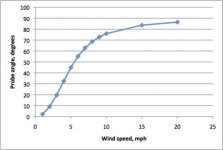I recently came into possession of a device/ gadget that looks like a wind indicator. Its called, "IBALL" Custom Benchrest by Barry Edgley. It came with no instructions. I was able to figure out how to to assemble it and set it up at the Range. I set up one of my wind flags to make a comparison of the sensitivity. I experimented with the balance adjustment in an attempt to get the device to indicate wind currents. We had light winds today, 5-10mph. There must be another part that goes with this probe ,that I'm missing. I had to get out my 150mph leaf blower when I got back home to make it indicate. I am not a big fan of probes. I"m Still struggling with the traditional flag design. This indicator caught my eye for some reason. So I decided to see if it would help improve my wind reading skills.
First thing I noticed was,it seems slow to respond in a side by side comparison with my Graham flags. I could not adjust it to keep up with my wind flags. What advice/opinions can some of the wind flag experts give that will convince me to keep this device in my wind flag box.

Glenn
First thing I noticed was,it seems slow to respond in a side by side comparison with my Graham flags. I could not adjust it to keep up with my wind flags. What advice/opinions can some of the wind flag experts give that will convince me to keep this device in my wind flag box.

Glenn


